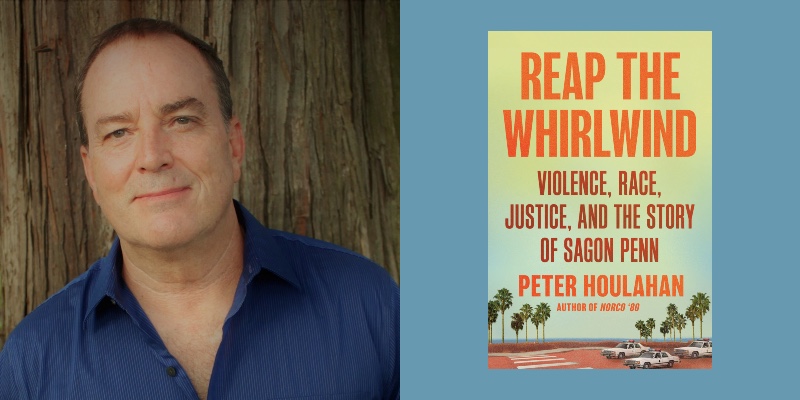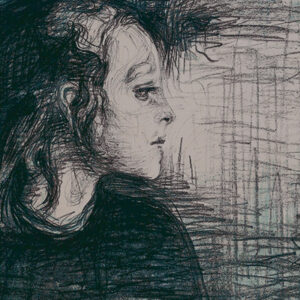Peter Houlahan’s Reap the Whirlwind: Violence, Race, Justice, and the Story of Sagon Penn is an engrossing, insightful account of a traffic stop gone horribly wrong. On March 31,1985, Penn, a Black man driving a pickup truck carrying several other Black men, was pulled over by Donovan Jacobs, a white cop accompanied by Sarah Pina-Ruiz, a civilian hoping to join the department. Asked for his license, Penn tried to hand his wallet to Jacobs, who refused to accept it.
This quickly turned into a physical confrontation, during which Penn—who, witnesses said, was fending off Jacobs’ unjustifiable attack—grabbed a gun from Jacobs. Penn shot and wounded Jacobs and Pina-Ruiz; he shot and killed Riggs. Penn then got behind the wheel of a police car, with which he ran over Jacobs, who survived, while fleeing the scene. Minutes later, Penn turned himself in. In two trials, jurors, persuaded that the traffic stop and the beating of Penn were unwarranted, acquitted him of murder and other charges.
“Had the story of Sagon Penn happened today,” writes Houlahan, who grew up in Southern California and lived in San Diego from 1979-84, “it would be a national media sensation.” In an interview, Houlahan, the author of the acclaimed book Norco ‘80: The True Story of the Most Spectacular Bank Robbery in American History, talked about the Penn case and its consequential aftermath, which included big changes in local policing, and, for some San Diegans, a period of reflection about racial discord.
You do a lot of helpful scene-setting in the book. Before the crime, the San Diego police department was viewed as one of the most progressive in the country. How did it get this reputation?
That came about not only with the political trends of Southern California, which were a little ahead of the rest of the country, but also with a police chief named Bill Kolender, who got the job in 1975. One of the first things he did was initiate a research project into the conditions regarding race and the treatment of minority communities. A few recruits had quit in the middle of training; they said, I’m not going to be part of this force. And he said, Let’s find out exactly what’s going on here.
They found–and this probably would have been true about almost any police force in 1975–that there was a lot of ingrained racism, and that there were a lot of abuses of power going on. So Kolender implemented new training techniques, and he aggressively tried to bridge the gap between minority communities—especially the small Black community—and the police force. The Black community leadership was also reaching back, and they were really making progress.
The Black population in San Diego, as you write, was then around 7 percent, about the same as now. Did Black residents feel like they had a voice in the community?
The Black community in San Diego had been mostly overlooked by the rest of the city. San Diego had become one of the 10 most populous cities in the country, but it just refused to believe it had become a big city. The attitude was always: We’re fun in the sun, we’re an exception to everything else that’s happening in big city America. All the forces that segregated Black communities in other places had also been at work in San Diego–redlining in real estate, the carving up of Black neighborhoods by freeways. There were harder drugs than in the past, and street gangs were fighting for drug markets. And the Black community was feeling underappreciated, overlooked, under-served.
Meanwhile, a lot of cops had been killed in the recent past. Did this influence how they engaged with the community?
One of the ways that San Diego was refusing to recognize it had become a big city was the size of its police force. Western U.S. police forces, per civilian, were relatively small compared to the big Eastern cities. San Diego’s was ridiculously small. They started to have officers killed in the line of duty in 1975 at a pretty alarming rate—10 over 10 years. A police officer in San Diego in 1985 was more likely to be killed in the line of duty than anywhere else in the country. They felt they were under siege, and I think that was coming up in their relationship with the citizens they were policing.
It’s against this backdrop that Penn is pulled over. Had he broken any laws?
The two officers involved—Donovan Jacobs and Tom Riggs—were in the neighborhood on a call for a gang member with a gun, who had threatened another young man. They left that scene and were looking for someone who would match that description. They saw Sagon Penn driving a white pickup truck. Ostensibly, Jacobs thinks that one of the people in the truck could be their subject.
That stop would’ve been OK if it had gone the way it should have gone. It should’ve been very apparent early on that nobody in that truck was doing anything wrong; certainly nobody had a gun. It should’ve been a quick conversation, and everybody should have gone on their way. But, of course, the incident blew up into something else. What became very problematic about that stop, is that when Jacobs was interviewed afterward, he said they made an illegal turn, they made an illegal signal, I pulled them over because this specific guy in the truck matched the description. But what was most likely happening is that Jacobs just took a look and said, I’m going to check that truck out. Jacobs had a reputation for stopping people without reasonable cause.
And he goes up to the truck and says to Penn, in effect, I think you’re a gang member.
Jacobs made a lot of what they call contacts—he got out there and he talked to people, and he made a lot of arrests. But his method was to shake people up. He gave people a hard stare or would ask people really aggressive questions. The idea was to see if they slip up, then he could go to the next step, which was probable cause to search. When he approached Sagon Penn’s truck, he was doing what he always did.
Penn stepped out of his truck. It’s universally agreed he was doing nothing wrong, nobody in the truck was breaking any laws. I think what’s critical–because this is what the jury believed–is that Jacobs set the tone for the whole interaction. This—Penn—was a young man who was flustered, and a cop who was aggressive. The jury felt like the adult in the room should’ve been Donovan Jacobs.There were too many opportunities for him to get control of the situation.
There’s a cinematic quality to your description of the neighborhood where this occurred. You tell us not only that there was a junk sedan sitting in a driveway, but also that it’s missing a fender. You tell us what Penn would’ve driven by that day—an auto-parts store, a tire store. How did you get this degree of detail?
There is news footage from the period. The news crews arrived almost the same time as the police. There are also scene photographs. I, of course, drove the routes back and forth to figure out which stores were there then. Crimes are incredibly well-documented, and if it goes to trial, there is an excruciating amount of documentation. But you have to get out there and drive those routes and talk to those people.
The same goes for your chapters on the trials. You write, for example, about the “hypnotic rhythm” of the closing argument made by Milt Silverman, Penn’s lawyer, in the first trial. You must’ve plowed through a lot of audio and transcripts.
I had 80 percent of the trial transcripts. I had a lot of snippets of video. I had a very good idea of how these guys behaved in court. I talked to jurors and got their impressions, and talked to other people who sat through the trial. And I spent a tremendous amount of time with Milt Silverman (who died in May 2024). I would go back to him and say, I want to take a look at your closing argument in trial one. When you’re saying this, are you saying it this way or are you saying it that way?
“It took the city” a while “to assess the damage from the Sagon Penn story being laid bare before them,” you write. What did the city see when it looked at itself afterward?
It had not been a very self-aware city before this. I think what happened with San Diego was that they had to pay attention because this was so astonishing—it was so gripping a trial, it kept refusing to fit into anyone’s preferred narrative. And what they realized is that they had big city problems, and that they had a police force that was too small. The police instituted some things to make their officers safe. They mandated bullet proof vests, they changed holsters so guns didn’t fall out. They also put in a civilian review board.
How would this case go differently if it happened today?
The way this really would’ve played out differently is in the media. The thing about the Sagon Penn trials is that they happened before 24-hour news channels, before social media and cell-phone cameras. Plus, this was a city that still felt it was an exception to the rule; it did not have deeply entrenched racial politics like you’d find in Philadelphia and New York City at that time.
I thought there was great value in slowing something like this down and taking a look at how it unfurled—not only at the incident itself, but how it impacts everything around it. And so while there was a tremendous amount of polarization among parts of San Diego, there was still a huge part of the city that said, Let’s wait and see what happens here, maybe we ought to try to do the right thing. I don’t think that would’ve happened nowadays; it’s too volatile.

















